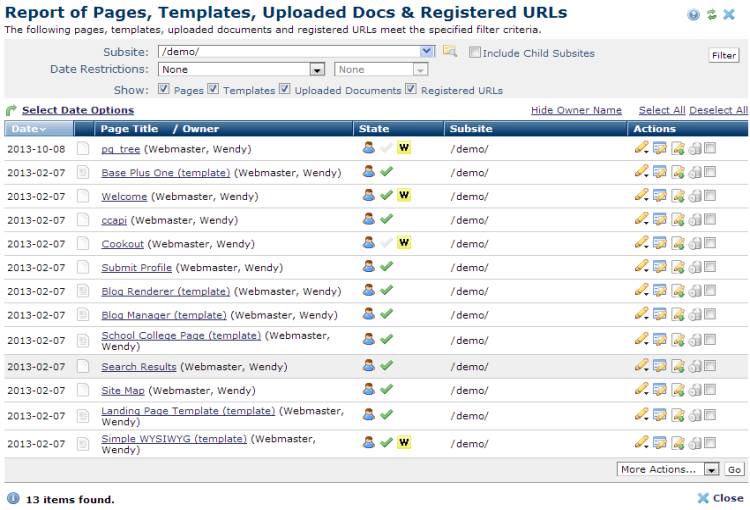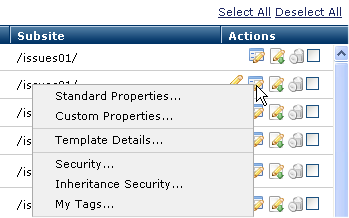
Access this dialog from the Reports menu.

Subsite - Select from the dropdown, or click the subsite search icon  . Optionally check Include Child Subsites to search the selected subsite and all the subsites it contains. Leave this unchecked to search the selected subsite only.
. Optionally check Include Child Subsites to search the selected subsite and all the subsites it contains. Leave this unchecked to search the selected subsite only.
Date Restrictions - Select from the dropdown:
Once you set a date restriction, you can further refine your search with options in the second date field. Picking a date restriction for past events displays past options only. Optionally pick from This week, Last week, This month, Last month, etc.
Show: Expand or restrict your view of CommonSpot file types by selecting/deselecting these options.
Use  Select Date Options to set the date that displays in the Date column. (Use the Date Restrictions search criteria to constrain results by specific dates.) Pick from the dropdown. A green checkmark
Select Date Options to set the date that displays in the Date column. (Use the Date Restrictions search criteria to constrain results by specific dates.) Pick from the dropdown. A green checkmark  indicates the current filter. Optionally choose from the following:
indicates the current filter. Optionally choose from the following:
Optionally Show/Hide owners' names.
Click an item in the Page Title column to display that page in the main browser window, for quick review. Owner name displays if you toggle that option, as shown above.
The State column indicates status for each page in this report. A green check mark  indicates currently active pages. This column also includes user
indicates currently active pages. This column also includes user  or group
or group  ownership status (where applicable). Mouseover to view owner details. State also displays standard CommonSpot Work In Progress and Approval Icons. A page may display one or more of the following:
ownership status (where applicable). Mouseover to view owner details. State also displays standard CommonSpot Work In Progress and Approval Icons. A page may display one or more of the following:
 Blue W indicates Work in Progress, scheduled for publishing.
Blue W indicates Work in Progress, scheduled for publishing.
 Orange P indicates Pending Approval.
Orange P indicates Pending Approval.
 Yellow W indicates newly created or modified content in a Work in Progress state, not ready for public distribution.
Yellow W indicates newly created or modified content in a Work in Progress state, not ready for public distribution.
 The calendar icon indicates a page scheduled for publication.
The calendar icon indicates a page scheduled for publication.
For more information, see Content States, Page View Modes, and the View Menu.
The calendar icon displays for pages scheduled for publication. State information does not display for uploaded documents or URLs.
In the Actions column, clicking the edit icon  displays the following.
displays the following.

Select a mode for viewing the page. Selecting All Changes, as shown above, opens the selected page for editing. See Content States, Page View Modes, and the View Menu in the CommonSpot Contributor's Reference for details on view modes.
Clicking the Metadata & Security icon  , as shown below, displays the following options.
, as shown below, displays the following options.

Select a page information option.
Standard Properties, Custom Properties: For these options, see the "Properties Menu" description in the CommonSpot Contributor's Reference. Properties displayed to authors derive from administrative settings made through the Site Administrator Page Creation/Properties UI option.
Details: Displays detailed information for the selected page, template, or uploaded file, in this case Template Details. See Page Details and Uploaded Document Details in the CommonSpot Content Contributor's Reference for information presented for these file types. The Details option does not display for registered URLs.
Security: Displays type-specific security settings for the selected item. Options displayed to authors derive from administrative settings. See Page Security, Template Security, Image Security, and Uploaded Document Security in the CommonSpot Content Contributor's Reference and Content Security in this document.
Inheritance Security:This option displays for objects that inherit security attributes from a parent object, such as templates or pages. See Template Inheritance Security. Click to view or change.
My Tags: Displays any personal tags associated with the page, template, or uploaded file. See "My Tags" in the CommonSpot Content Contributor's Reference.
Clicking the More Actions icon  , as shown below, displays the following options.
, as shown below, displays the following options.

See the CommonSpot Content Contributor's Reference for more information on each of these options.
Click one or more checkboxes, or Select/Deselect All and select the appropriate option from the More Actions dropdown to copy, move, or delete pages. You can also selectively delete individual pages by clicking the delete icon for a single item.
Note: Unlike pages, which can exist in a different subsite with the same title (index, for example), templates copied to another subsite must have unique names.
A warning displays if the number of records exceeds the limit defined in the Maximum Records field for Admin Reports for the site. See the description of the UI Scalability tab under Site Properties/Settings for information on customizing reports.
Related Links
You can download PDF versions of the Content Contributor's, Administrator's, and Elements Reference documents from the support section of paperthin.com (requires login).
For technical support: